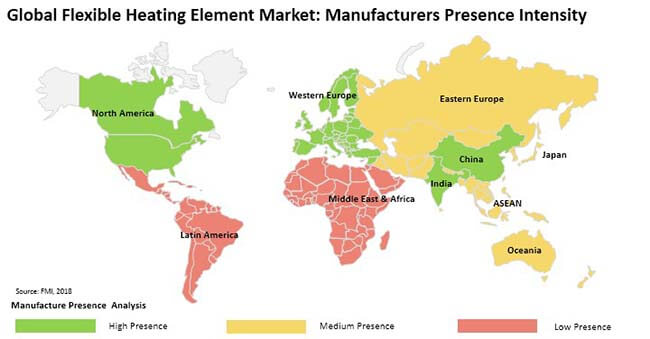Flexible heating elements find application in various areas, such as hotplates, tank heating, cabinet warming/telecoms, drum heating/trace heating and refrigeration/catering equipment. Attributing to such diverse applications, the demand for flexible heating elements is expected to increase at a significant rate during the forecast period.
The advantage of using a flexible heating element is that it provides high heat transfer efficiency. Moreover, it provides faster heat up and cool down rates and uniform heat distribution. Another advantage of a flexible heating element is its geometry, as it permits the heating of holes, notches, and unusual shapes. It also offers high dielectric strength. Flexible heating elements are used in a wide range of industrial and commercial applications, can be configured as wire wound or etched foil and can be quickly equipped with a number of materials and devices. In addition to this, they are an economical solution. Major applications for flexible heating elements include telecommunication, vehicles monitoring, pharmaceutical, packaging, food and various consumer products. Flexible heating elements are thin and can be used in areas that have less space and installed around tight corners and complex shapes. With the help of flexible heating elements, multiple circuits and multiple voltages in a single element are now an option.
Silicone heater mats are made of etched heating foils or heating wires, which are insulated and encapsulated between two silicone mats supported by textile glass fibers. Silicone heater mats are appropriate for applications that require homogeneous heat and precise temperature distribution. Attributing to low thermal mass, silicone heater mats are distinguished by excellent controllability and quick response. The small construction height and low mass of silicone heater mats make them remarkable for various aerospace applications. Resistance against humidity and moisture endorses these mats for catering appliances, laboratory equipment and electronic components.
With the growing demand for customized products across various end use industries, flexible heating elements offer a better alternative when compared with conventionally used methods.
Asia Pacific is expected to witness robust growth in the demand for flexible heating elements during the forecast period, which can be attributed to the increasing use of these elements in food, semiconductor and pharmaceutical industries. China is expected to dominate the flexible heating element market in terms of production as the country has a high number of manufacturers and distributors of these elements when compared with other regions.
North America and Europe are expected to witness significant growth in the demand for flexible heating elements during the forecast period, which can be attributed to the growing semiconductor industry in the U.S & Germany, coupled with growth in the food industry. Middle East & Africa (MEA) and Latin America are expected to witness steady growth in the demand for flexible heating elements during the forecast period.

Examples of some of the key participants in the global flexible heating element market are:
Market participants in China have an opportunity to expand their manufacturing facilities in other regions, especially India, North America and Europe. Market Participants in North America and Europe have an opportunity to form joint ventures or collaborations to gain significant market shares in the flexible heating element market.
FMI will follow a modelling-based approach and triangulation methodology to estimate flexible heating element market data covered in this report. A detailed market understanding and assessment of the nature, product type and end uses of the product segments covered in the study are followed by a demand-side analysis to estimate the sales of target product segments, which is then cross-referenced with a supply-side assessment of value generated over a pre-defined period. The statistics and data are collected at a regional level and consolidated and synthesized at a global level to estimate the overall market sizes.
Flexible heating elements are used for applications that involve a heater with low thermal mass, complex geometry, minimal thickness and lightweight construction. They are utilized where uniform heating is required but space is a problem.
By product type, the flexible heating element market can be segmented as:
By application, the flexible heating element market can be segmented as:
Some of the key data points covered in our report include:






Full Research Suite comprises of:
Market outlook & trends analysis
Interviews & case studies
Strategic recommendations
Vendor profiles & capabilities analysis
5-year forecasts
8 regions and 60+ country-level data splits
Market segment data splits
12 months of continuous data updates
DELIVERED AS:
PDF EXCEL ONLINE
Flexible Packaging Paper Market Size and Share Forecast Outlook 2025 to 2035
Flexible Plastic Packaging Market Size and Share Forecast Outlook 2025 to 2035
Flexible Rubber Sheets Market Size and Share Forecast Outlook 2025 to 2035
Flexible Printed Circuit Boards Market Size and Share Forecast Outlook 2025 to 2035
Flexible Packaging Machinery Market Size and Share Forecast Outlook 2025 to 2035
Flexible Electronic Market Size and Share Forecast Outlook 2025 to 2035
Flexible Foam Market Size and Share Forecast Outlook 2025 to 2035
Flexible Plastic Packaging Industry Analysis in United States Size and Share Forecast Outlook 2025 to 2035
Flexible Protective Packaging Market Size and Share Forecast Outlook 2025 to 2035
Flexible AC Current Transmission System Market Size and Share Forecast Outlook 2025 to 2035
Flexible End-Load Cartoner Market Size and Share Forecast Outlook 2025 to 2035
Flexible Packaging Market Size and Share Forecast Outlook 2025 to 2035
Flexible Screens Market Size and Share Forecast Outlook 2025 to 2035
Flexible Metallic Conduit Market Size and Share Forecast Outlook 2025 to 2035
Flexible Electrical Conduit Market Size and Share Forecast Outlook 2025 to 2035
Flexible Display Market Size and Share Forecast Outlook 2025 to 2035
Flexible Substrate Market Size and Share Forecast Outlook 2025 to 2035
Flexible Paper Battery Market Size and Share Forecast Outlook 2025 to 2035
Flexible Metallic Tubing Market Size and Share Forecast Outlook 2025 to 2035
Flexible Barrier Films for Electronics Market Size and Share Forecast Outlook 2025 to 2035

Thank you!
You will receive an email from our Business Development Manager. Please be sure to check your SPAM/JUNK folder too.
Chat With
MaRIA